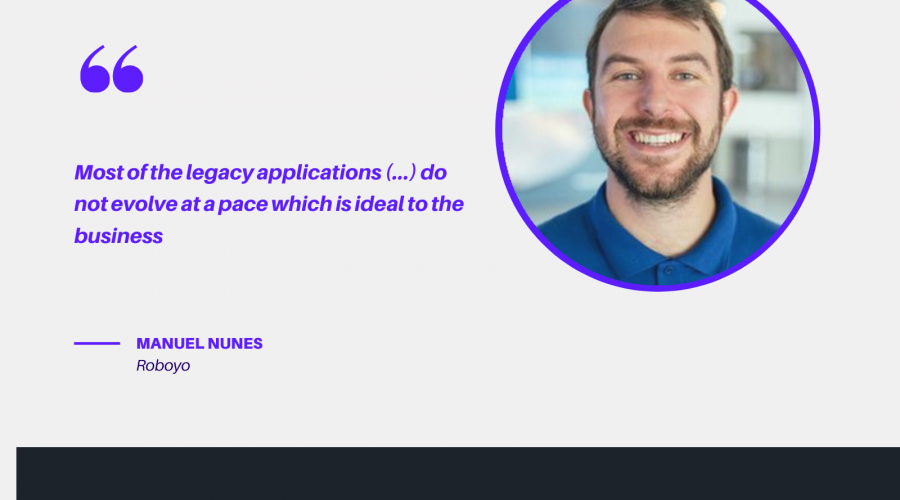How RPA is Leading The Way To a More Empowerment Future?

Written by: Laura Simas (4-min reading)
How is RPA revolutionizing the way business works?
As the world is moving forward by using various technologies, so has automation improved its ways of making our work easier. Robotic process automation (RPA) is revolutionizing the way businesses work, eliminating tedious tasks and freeing people to focus on higher-value work.
However, RPA “requires proper design, planning and governance if it’s to bolster the business,” according to Manuel Nunes, Senior Consulting Manager from Roboyo.
In yet another riveting episode of Automation Talks, a podcast where we have genuine and insightful conversations about the future of our species in an era of machines, automation, and AI, we invited Manuel Nunes to give us a deep dive into the world of RPA.
Manuel Nunes, a Senior Consulting Manager from Roboyo, has vast experience in the RPA industry in different geographies, working on interesting projects alongside companies such as Citi Group, Boston Consulting Group, Blue Prism, and others. In Citi Group, he had the opportunity to advise on the best technologies related to RPA “including Tech Stack Comparison (Automation Anywhere, Blue Prism, UiPath, and Workfusion)” which allowed the development of a “process discovery session related to automation in different departments.”
RPA – Robotic Process Automation
Although RPA is a trending topic of discussion in many businesses nowadays, the concept is not clear to everyone, causing many to look at these solutions as threats to their future in the workplace.
According to Manuel Nunes, the easiest way to understand what RPA is is to “recall the pianos we normally see in the shopping centers, which replicate a human playing a song in all its glory, all by itself.”
The same concept is applied to “business processes, mainly administrative and repetitive tasks, which have a high volume of transactions, where a computer, typically a virtual machine, replicates tasks.” In summary, RPA is the use of machines to perform tasks with high precision at rapid intervals.
These implementations are only possible “because there are several business rules with defined logic behind them, which can be mapped and built into a machine to replicate the repetitive tasks that a human undertakes on a daily basis.” A distinct aspect of virtual robots is that their actions are performed based on the end-user perspective.
This gives additional visibility into the viability of software or a process that a system monitoring tool would not address. Usually, these transactions are performed repetitively and at high volumes, since the virtual robots are able to run 24/7.

It is quite curious that most of the initiatives related to automation solutions come directly from the business side rather than the technical or operational side of an organization.
According to Manuel Nunes, “most of the legacy applications (an information system which is critical to a day-to-day operation) do not evolve at a pace which is ideal to the business, not allowing the organization to grow at an expected rate.
This lack of capability to evolve can be directly related to changes in internal processes, legislation changes, which affect the capacity to adapt quickly in order to follow the market changes.”
Traditionally, these changes would involve the growth of the operation team, which would increase the internal costs in parallel. RPA solutions are able not only to adapt to any changes—internally or externally—but also to help organizations cut costs on repetitive tasks that have no benefit for the individuals or for the organization.
Evolution of RPA Solutions – from the 1990s Until Now
Automation has been around for some time.
The evolution of RPA started from simple screen scraping automation in the 1990s, to workflow automation, and finally evolving to recording and scripting capabilities in order to support different workflow automations.
Currently, robotic automation is already leveraging AI and machine learning capabilities, elevating the capability to evolve and learn with the repetition processes.
According to Manuel Nunes, “in Roboyo we are finding more and more companies adopting RPA solutions focused on a specific business case, which can be directly related with the accounts payable or with e-commerce, which are seen as out-of-the-box solutions, to really highly complex processes that required several check-lists and the involvement of different departments."
The rise in awareness points to the growing number of capable providers and the increasing usage by companies that are finding value in virtual robots.
Finding Effectiveness Through RPA Solutions
Digital effectiveness is all about organizations enjoying real-time process flows forged through the elimination of manual process break-points and the intelligent linking of data patterns across the front and back offices.
RPA is a critical building block in facilitating this journey, but ultimately it’s the whole “one office” concept, not the sum of the parts, that matters for true real-time effectiveness.
This is about one integrated organizational unit, where teams function autonomously across front, middle and back-office functions and processes to promote real-time data flows and rapid decision making, based on meeting defined outcomes.
In the future, the front, middle and back offices will cease to exist, as they will simply be OneOffice, and RPA has a critical role to play in supporting the building blocks.
Find out more about RPA in the Automation Talks episode by Manuel Nunes, Senior Consulting Manager from Roboyo.